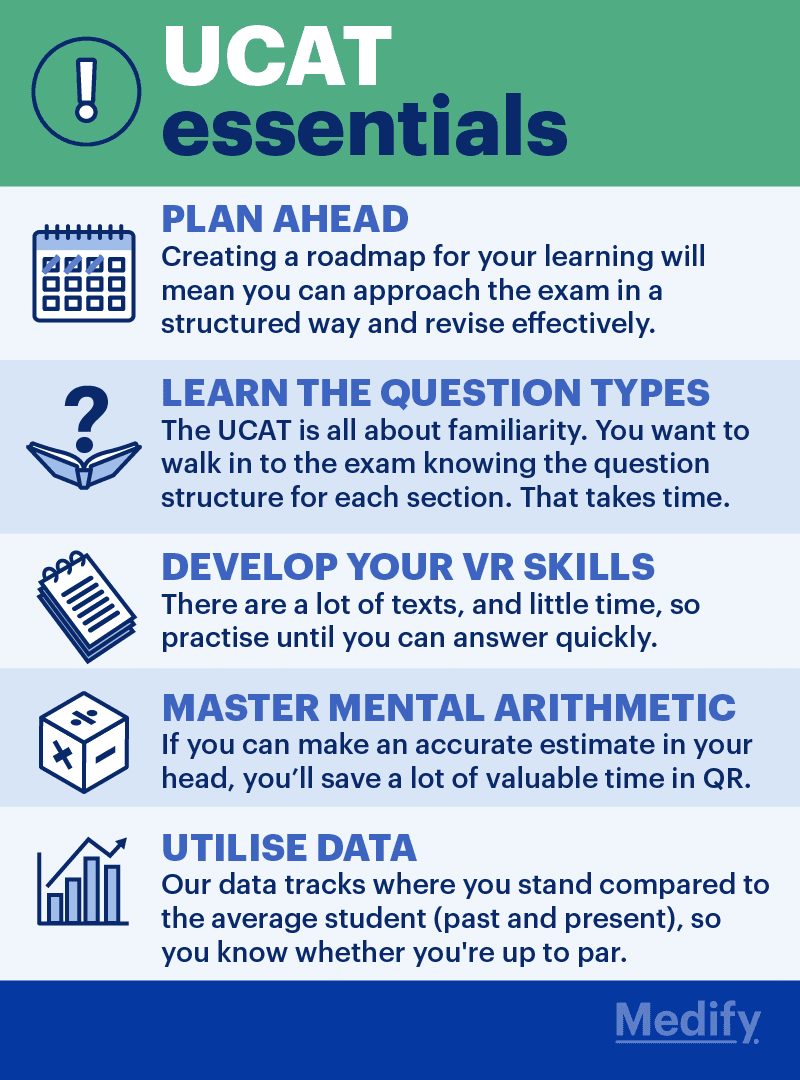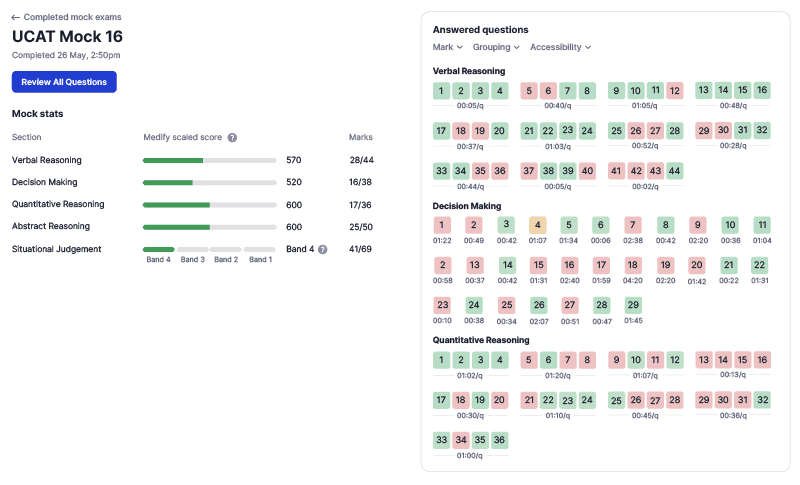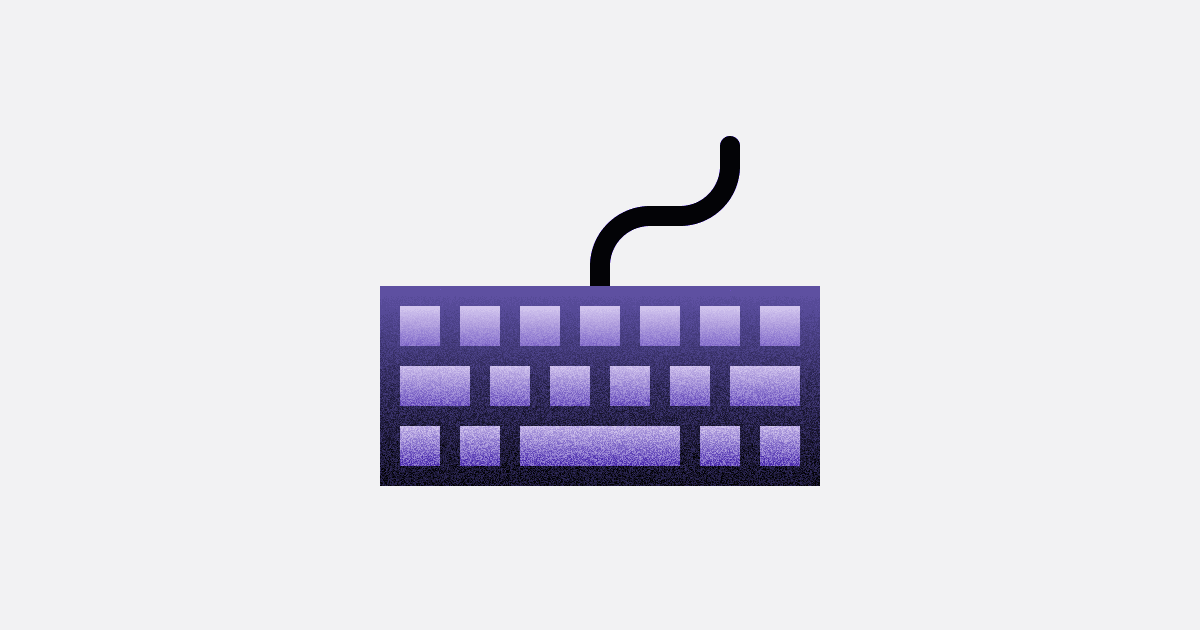UCAT Practice Questions 2025: Free UCAT Revision Resources
Prepare for the 2025 UCAT exam with our free worked example questions and free practice UCAT test. Get everything you need to boost your UCAT score here.

This article is written specifically for UK students.
Read the ANZ version here.
The UCAT is notoriously difficult. Do you have your strategy in place yet?
Once you’ve learned from the worked examples below, you’ll find a link to our free UCAT practice test towards the bottom of the article. This will give you a feel for the exam, so you know what you’re up against.
Finally, use this information in conjunction with UCAT preparation tips to create your revision plan.

UCAT practice questions and exam techniques
Below you'll find a breakdown of each UCAT section with practice questions.
If you're just starting your UCAT preparation, going through these practice questions can help you get an idea of what each section is like, as well as learn about effective techniques for improving your performance.
Verbal Reasoning question
Time yourself reading the text and answering the question below.
Before you start, consider:
Which part should you read first?
Try to exclude some possibilities in less than 15 seconds.
The first line or two normally reveal the purpose of a paragraph. Check whether these lines suggest the paragraph will contain the information you need.
VR reading comprehension: worked example
Fast Fashion
Fast fashion is a contemporary term used by fashion retailers to express how designs quickly move from the catwalk to capture current fashion trends. Fast fashion clothing collections are based on the most recent fashion trends presented at Fashion Week in the spring and the autumn of every year. Emphasis is on optimising certain aspects of the supply chain for these trends to be quickly and inexpensively designed and manufactured allowing the mainstream consumer to buy current clothing styles at a lower price. This philosophy of quick manufacturing at an affordable price is used in large retailers such as H&M, Zara, Peacocks, Primark and Topshop. It particularly came to the fore during the vogue for ‘boho chic’ in the mid-2000s.
This has developed from a product-driven concept based on a manufacturing model referred to as ‘quick response’ developed in the USA in the 1980s and moved to a market-based model of ‘fast fashion’ in the late 1990s and first part of the 21st century. Zara has been at the forefront of this fashion retail revolution and their brand has almost become synonymous with the term, but there were other retailers who worked with the concept before the label was applied, such as Benetton. Fast fashion has become associated with disposable fashion because it has delivered designer products to a mass market at relatively low prices.
The slow fashion movement has arisen in opposition to fast fashion, blaming it for pollution (both in the production of clothes and in the decay of synthetic fabrics), shoddy workmanship and emphasising very brief trends over classic style. Fast fashion has also come under criticism for contributing to poor working conditions in developing countries. The Savar building collapse in Bangladesh in 2013, the deadliest garment-related accident in world history, brought more attention to the safety impact of the fast fashion industry.
Attribution: Wikipedia
Fast fashion is:
A. Based on the quick response concept of the 1990s.
B. A response to the slow fashion movement.
C. A concept of bringing designs quickly from the catwalk to the stores.
D. Designed by Zara.
Verbal Reasoning answer
The correct answer is C.
How long did you take?
In the test there is little time to return to a passage more than once – saving time is key.
Some VR tricks
Did you read the question first?
Did you skim the text to see that the ‘quick response concept’ was developed in the 1980s, and that Zara was listed among many other retailers?
If you read the first lines of the paragraphs, as suggested, you’ll have saved time as the answer is given at the beginning of the text.
The Verbal Reasoning section has many ways to catch you out, and sometimes answers aren't explicit in the text so have to be inferred.
Remember: without regular timed practice and realistic questions, it's hard to get through this section in time.
Get more UCAT Verbal Reasoning tips
Decision Making question
Before you start, consider:
Make a note, if needed, when you exclude an answer (you don’t want to lose track of your thought process).
DM logical puzzle: worked example
Zara, Mo, Jill, Gwen, and Owen all use different coloured pens to take notes in lessons. Their pens are either fountain pens or ball-point pens, and each pen has either black, gold, or red ink.
Jill and Owen do not have fountain pens.
Two of the pens are ball-point pens, and the rest are fountain pens.
Only Mo has a pen with red ink.
All ball-point pens have black ink, whereas all the other pens have either gold or red ink.
Which of the following statements is true?
A. Jill has a pen that uses black ink.
B. Zara has a ball-point pen.
C. Owen has a pen that uses gold ink.
D. Both Mo and Gwen have pens that use red ink.
Decision Making answer
The correct answer is 'A. Jill has a pen that uses black ink’.
The statement tells us that ‘two of the pens are ball-point pens and the rest are fountain pens’, and that ‘Jill and Owen do not have fountain pens’.
Thus, Jill must have a ball-point pen. As it states ‘all ball-point pens have black ink’, Jill must have a ball-point pen that uses black ink.
No direct numerical data is given in the question that needs to be interpreted or calculated to come to an answer.
Get more UCAT Decision Making tips
Quantitative Reasoning question
Before you start, consider:
What units will the answer be in, metres squared or a number?
Even though area is one of the more basic calculations, time yourself to see if you manage to do it within a maximum of 41 seconds.
QR geometry: worked example
James has been working on renovating his bungalow. Below are the blueprints for the building. Recently, James has built a conservatory in his garden to replace the flowerbed. All walls are 3m high. The image is not to scale.
James wants to replace the floor in the kitchen. However, flooring can only be purchased in 1 m squares. How many squares does James need to purchase?

Quantitative Reasoning answer
The answer is deduced by calculating the area of the kitchen i.e. the product of the length and width.
In the blueprints, we are given the width of the room as 4.5m, but the length of the kitchen must be calculated using the lengths of the corridor and WC.
We can see from the blueprints that the length of the kitchen is equal to the length of the corridor and WC (5.5m) minus the length of the corridor (2m), so 5.5m − 2m = 3.5m.
The area of flooring required can be calculated as the area of the room: length × width = area 3.5m × 4.5m = 15.75 m2.
Therefore James must buy 16 squares.
Did you use a calculator? Guesstimation is critical, but so is efficient calculator use. Check out 8.5 tips to master the UCAT calculator.
Get more UCAT Quantitative Reasoning tips
Situational Judgement question
Before you start, consider:
Patient-centred care is central to working in medicine. Don’t forget to demonstrate professionalism and empathy.
Situational Judgement orientation: worked example
Emily is a medical student on placement at a GP surgery. She has been asked to call the next patient in, when she sees Mr Jones, one of the regular patients at the surgery, yelling at the receptionist about his appointment.
The other patients in the waiting room seem distressed, but too apprehensive to speak. As soon as he sees Emily, Mr Jones turns to her and exclaims that the receptionist made a mistake and that he has been waiting for 3 hours as a result.
How appropriate are the following responses by Emily in this situation?
1. Berate the receptionist for making a mistake.
2. Explain to Mr Jones that mistakes sometimes happen.
3. Tell Mr Jones that the doctor won’t see him if he does not calm down.
4. Ask Mr Jones to explain what happened.
5. Promise Mr Jones the doctor will see him immediately.
Situational Judgement answer
The answers are:
1. Very inappropriate.
2. Inappropriate, but not awful.
3. Very inappropriate.
4. Very appropriate.
5. Very inappropriate.
Get more UCAT Situational Judgement tips
Other free UCAT resources
Medify has a free Admissions Guide and a range of blog articles with comprehensive UCAT exam advice.
The official UCAT site has test examples you can work through, plus great resources such as this interactive overview of the UCAT exam.
Pearson VUE provide UCAT practice exam papers that you can try.
The General Medical Council’s Good medical practice is a useful read for help with communication, maintaining trust, patient safety, and teamwork – all part of the Situational Judgment Test.
Why attempt more UCAT questions?
1. Familiarise yourself with the exam environment
Stress is almost unavoidable on exam day, and reducing your cognitive load is essential. Taking more mocks under exam conditions helps you familiarise yourself with the test, and familiarity means less stress.
Want to learn to deal with stress better? Explore our UCAT mindset mastery guide.
With every question answered, you learn more about the tiny details of the exam. This could be tricks for types and subtypes of questions, or how you personally respond to certain sections.
2. Reduce mistakes
Some UCAT candidates can't translate their hard work into good results. This is often due to making mistakes or slip-ups – moments of inattention when rushing can often cause you to lose marks in this way.
The good news is that the more questions you do... the more mistakes you make. What better way to learn than from getting it wrong once?
Plus, with our review function, you gather data about your performance as you practice, so you can gradually hone your skills.
3. Learn time management
In the UCAT, everyone has the same arch-enemy: the time limit. It can be difficult even for academically gifted candidates to get the maximum possible marks.
Verbal Reasoning, for example, requires candidates to read 250-400 word articles and respond accurately in an average of 28 seconds. Lingering on a question will mean losing marks later in the test.
As you attempt mock exams, you learn time management strategies that will save you valuable seconds on the day.
4. Get the edge on the competition
All UCAT candidates’ scores are divided into a percentile ranking, which represents the proportion of students you have outperformed. For example, 85th percentile means you've scored better than 85% of the test-takers. This system compares your score to the other students in your year.
By attempting UCAT mock questions on a regular basis and rectifying any mistakes, you will see your score increase against the average. We even have a graph to show you where you stand (needless to say, your confidence grows along with your position).
Oh, and one important thing: 2 in 3 UCAT takers use Medify, so our data is the most accurate and complete available.

Is Medify worth it?
Trying to piece together the exam from free questions all over the internet is unlikely to give you a competitive edge over the majority of UCAT test takers who use our platform.
Did you know that 2 in 3 prepare for the UCAT with Medify? Our students have the advantage of:
The largest UCAT question bank – Never stop improving your score, with 20,000+ questions.
The biggest data set in the world – Compare results to past and present students to highlight your strengths and weaknesses.
Affordable prices – We're passionate about widening access to medical and dental school, which is why our prices start at just £15.
50+ hours of video tutorials – Follow step-by-step expert guidance on how to beat each UCAT section.
If you need help preparing for the UCAT, check out our award-winning UCAT preparation course.
In addition to the above, it provides 24 unique full mock exams, 34+ mini-mock exams and question walkthroughs.
Summary
Learn about each UCAT section as early as possible when you start UCAT preparation.
Speed reading and selective reading are essential skills for the VR section.
Make notes as you develop your reasoning, particularly for Decision Making. This can save valuable brain processing space and make it easier to pick up where you left off.
Mental arithmetic is important to practise for Quantitative Reasoning, as there is little time to use a calculator.
Many universities look at results comparatively, so you often need to achieve a high score compared to others in your year.
We also suggest learning about our recommended approach to UCAT preparation which you can find in our UCAT revision roadmap.
Got unresolved queries? We answer 40 top questions about the UCAT here.
On this page
More like this

5 Keyboard Shortcuts to Save Time During the UCAT
These UCAT keyboard shortcuts can actually boost your score by giving you more thinking time.

10 Common GAMSAT Preparation Mistakes to Avoid
Wondering what mistakes students make while preparing for the GAMSAT? We explore the top 10 common GAMSAT pitfalls to avoid.

20 Tips to Change the Way You Think About the UCAT SJT
Tips and tricks to ace the UCAT Situational Judgement Test (SJT). Includes SJT practice questions and explanations.
ANZ version available
Start your journey with Medify today ·
Start your journey with Medify today ·
Start your journey with Medify today ·
Start your journey with Medify today ·
Start your journey with Medify today ·
Start your journey with Medify today ·
Start your journey with Medify today ·
Start your journey with Medify today ·
Start your journey with Medify today ·
Start your journey with Medify today ·
Start your journey with Medify today ·
Start your journey with Medify today ·
Start your journey with Medify today ·
Start your journey with Medify today ·
Start your journey with Medify today ·
Start your journey with Medify today ·
Start your journey with Medify today ·
Start your journey with Medify today ·

Join the 2 in 3 UK applicants who use Medify
That’s 220,000 students since 2009
Resources
© Medify Ltd 2009-2025